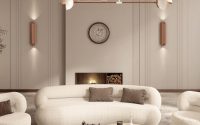Lampshades – The Ideal Accessory for Subtle Home Décor
When it comes to decorating your home, in most cases, less is more. It is no wonder, considering how Scandinavian and minimalist styles are adored by a great portion of the world. Both styles strive for decreasing the visual clutter in your home and just leaving the practical items. And this is not solely for aesthetic reasons – multiple studies have shown that clutter can cause anxiety and make it hard to focus on a single item or task.
This is no reason to give up on home accessories though. Instead, we can use subtle and practical items to enrich our living space. When fewer items are fighting for our attention, we can truly admire a piece of wall art or another decorative piece. To achieve this, we can pay more attention to the quality and function of our home’s accessories, rather than their quantity.
Take lampshades for instance. They are the ideal item we can use to decorate our home in a subtle and stylish way by adding more functionality to it. Lamps are practical items used for lightning specific spots in a room and they can also serve as decorative pieces. And unlike sofas and armchairs, lampshades aren’t as expensive. This makes them the perfect home accessory with which you can experiment. A bold and unique pattern can add character to your living room or make your bedroom look more intimate.

How to Mix and Match Lampshades with Your Furniture
Usually, the bigger pieces of furniture, such as sofas, armchairs, tables, and cabinets are monochromatic. And considering how most walls are painted in a plain color, they can unintentionally make your room look dull. This is where lampshades with a patterned and colorful design can come in handy. You can break the color monotony in your living room and make a bold statement with this useful piece of home accessory.
If your home features minimalist colors, you can opt for lampshades with a floral, geometrical or even animal pattern! You can also use them to give a more put-together look to your mixed and matched furniture. Let’s say you have a beige armchair and a navy sofa. The colors probably complement each other well on their own, however, by adding a beige and navy lamp shade, you can subtly improve the color combination.
Then, there are rooms styled primarily in brown and green colors. If you have a houseplant positioned on one side of the room, you can add a lampshade with a green leaf or floral pattern on the other side. This way you will keep the number of colors to a minimum while still having a fun pattern or design. And finally, if there are already too many colors in your home, you can tone it down a bit with a lampshade that has a minimalist pattern containing just two tones of the same color.

How to Match a Lampshade with a Lamp
A wooden looking lamp would probably go really well with green, brown or red lampshades. These types of lamps look good with wooden tables or other wooden elements. And you don’t need to use this piece of décor strictly inside – they can look great with your patio furniture too, depending on the material. White lamps can be matched with a lampshade that has this color in the pattern. See-through glass lamps or black metal ones don’t exactly stand out, so you can experiment with different types of lampshades. However, have this simple rule in mind – only one of them should stand out. If your lamp is plain-looking, you will have more options when picking out the lampshade. And vice versa – if the design is eye-catching, the lampshade should look simpler, so as not to draw attention from the lamp.

How to Choose the Material of the Lampshade
The material can greatly influence the texture of the lampshade. I think that natural, plant-based fabrics have the best texture. They give a homely and comfortable feeling to the interior. There is a variety of cotton and linen lampshades that can suit your needs. Since cotton is white and absorbent, it is one of the easiest fabrics to dye. Furthermore, cotton is a breathable fabric that provides airflow.
When speaking about lampshades, these properties probably don’t sound that important. After all, it is not like the fabric will be in close contact with your skin, right? It will, however, be in close contact with your light bulb. Incandescent light bulbs work by heating a filament which then produces light. These bulbs can get extremely hot. You can see now why it is important to not have a material that blocks heat close to them.
Of course, by choosing a natural fabric you will also be fighting the green fight in order to save the environment. Natural and organic fibers are more sustainable and don’t pollute the environment as much.



